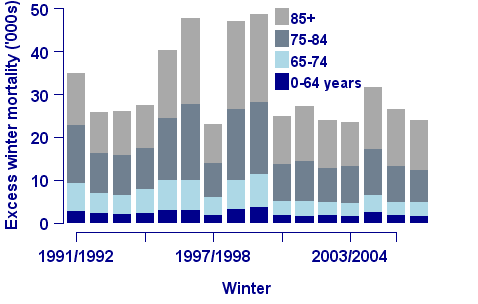Winter mortality
In previous posts we looked at seasonal fluctuations in mortality. Since the UK is about to experience some particularly cold weather again, we will look at winter mortality in more detail.
The Office for National Statistics in England and Wales produces statistics comparing the mortality of three winter months with three summer ones. These statistics take the form of excess numbers of deaths in winter, as shown in the graph below:

As can be seen in the above graph, it is the elderly who bear the brunt of excess winter mortality. There are a number of reasons for this, of which one of the best known is influenza, which is particularly infectious during winter months. Influenza can kill directly, but it often sets a chain of events in motion which lead to death due to other causes such as heart attacks. It is believed that for every death directly attributed to influenza, there are several more where influenza played a hidden role.


Add new comment